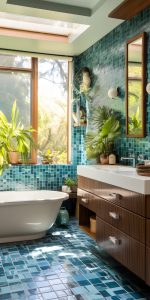Eco-friendly Shower Floor Sealants: Sustainable Solutions for a Watertight Bathroom
When it comes to keeping your bathroom watertight sealing the shower floor is an essential step. However, many people are now looking for eco-friendly alternatives to get the work done while minimising environmental impact. Eco-friendly shower floor sealants offer a sustainable way to protect your shower from leaks while avoiding harmful chemicals often found in traditional products. If you’re wondering how to reseal my shower in a way that’s good for both your home & the planet here’s a comprehensive guide on sustainable sealing solutions.
What Makes a Shower Floor Sealant Eco-friendly?
Traditional sealants often contain chemicals such as volatile organic compounds (VOCs), which can release harmful fumes into the air. These substances not only harm indoor air quality but can also negatively impact the environment when they’re manufactured or disposed of.
Eco-friendly shower floor sealants, on the other hand, are made from natural, non-toxic ingredients. They offer the same watertight protection for your shower without the harmful side effects. Many eco-friendly sealants are low in VOCs or completely VOC-free, making them a safer choice for your home and the environment.
These sealants are also designed to be durable, ensuring that your bathroom stays leak free for years. Some products even come with water-based formulas that are biodegradable ensuring they break down safely without polluting water systems.
How Eco-friendly Sealants Protect Your Shower
A high-quality eco-friendly shower floor seal provides a strong barrier between the floor and any water that hits it. By preventing leaks, you can avoid costly water damage that can ruin your tiles, grout and the subfloor beneath. Whether you have a tiled shower floor or one made of another material, resealing it periodically keeps your bathroom in top condition.
By opting for sustainable sealing products, you’re also helping to reduce the negative impact on the environment. These products are designed to last longer, meaning you’ll need to fix the shower seal less frequently. This reduces waste & limits the number of toxic materials that could potentially end up in landfills or waterways.
Benefits of Eco-friendly Shower Floor Sealants
- Non-toxic Ingredients Eco-friendly sealants are made from natural or biodegradable materials, making them safer for both humans and the environment. Unlike chemical-laden alternatives, these products won’t release harmful fumes into your bathroom.
- Low Environmental Impact Many sustainable sealants use water-based formulas that are biodegradable. This means they break down naturally over time and don’t add to pollution when they’re washed away or disposed of.
- Long-lasting Protection Despite being eco-friendly, these sealants don’t compromise on performance. They offer long-lasting protection against leaks, reducing the need for frequent reapplications. This not only saves time and money but also helps lower the overall environmental impact.
- Safe for Homes with Children and Pets Because they contain fewer or no harmful chemicals, eco-friendly sealants are a safer option for households with children or pets. You can use them with peace of mind, knowing they won’t cause health issues.
How to Apply Eco-friendly Shower Floor Sealants
Applying an eco-friendly shower floor sealant is quite similar to using a traditional one. However, it’s important to check the specific instructions for the product you choose. Here’s a general guide:
- Clean the Shower Floor Before applying the sealant, make sure the shower floor is clean and free of any soap scum, dirt, or mildew. A clean surface ensures better adhesion and a more effective seal.
- Dry the Area After cleaning, let the shower floor dry completely. Sealing on a wet surface can trap moisture underneath, which may lead to problems later.
- Apply the Sealant Follow the product instructions to apply the eco-friendly sealant evenly across the shower floor. Use a brush or a sponge if required, making sure to cover all the necessary areas, especially corners and edges.
- Let it Cure Once applied, allow the sealant to cure as recommended by the manufacturer. This may take several hours or even overnight, so it’s important not to use the shower during this time.
- Reapply as Needed While eco-friendly sealants are long-lasting, they may still need to be reapplied over time to maintain their effectiveness. Check for any signs of wear or damage and reapply as necessary.
Top Eco-friendly Sealant Options
Several companies now offer eco-friendly shower floor sealants. Some popular choices include:
- EcoSeal: A water-based, VOC-free sealant that offers durable protection against leaks while being gentle on the environment.
- AFM Safecoat: Known for its non-toxic formula, this sealant is perfect for those looking to protect their homes and the environment.
- Enviroseal: This product boasts low VOCs and is ideal for use in eco-conscious households.
By choosing one of these products, you can effectively fix shower seal issues without resorting to harmful chemicals.
FAQ
Q: How often should I reseal my shower floor? A: Generally, it’s recommended to reseal your shower floor every 1-2 years, depending on the type of sealant used and how heavily the shower is used. Eco-friendly sealants may last just as long as traditional ones but should be checked regularly for signs of wear.
Q: Can I apply eco-friendly sealants myself? A: Yes, applying an eco-friendly shower floor seal is usually a simple DIY task. Just make sure to follow the product instructions carefully and allow enough time for the sealant to dry properly.
Q: Are eco-friendly sealants as durable as regular ones? A: Yes, many eco-friendly sealants offer the same durability and watertight protection as traditional products. Some are even more resistant to wear and tear, reducing the need for frequent reapplication.
Q: Do eco-friendly sealants prevent mould and mildew? A: Yes, by creating a strong barrier that prevents water from seeping into the floor, eco-friendly sealants help reduce the growth of mould and mildew in your bathroom.
By using eco-friendly shower floor sealants, you can reseal my shower with peace of mind, knowing you’re making a choice that’s safe for both your home and the environment.



 Home offices are getting the most attention from home owners, but so do kitchens and bathrooms. Showers in particular are also getting some needed upgrades and repairs as people spend more time at home.
Home offices are getting the most attention from home owners, but so do kitchens and bathrooms. Showers in particular are also getting some needed upgrades and repairs as people spend more time at home.